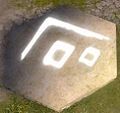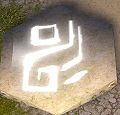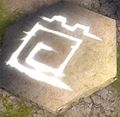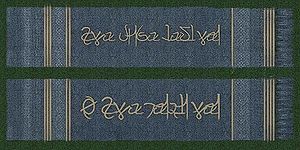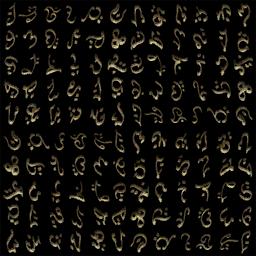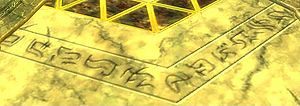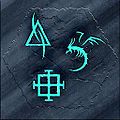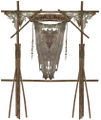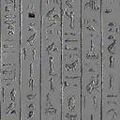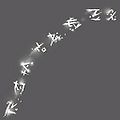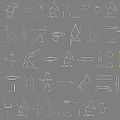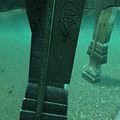Language
 This article is about languages in Tyrian lore. For real-world languages supported by the game client, see Running the game#Languages.
This article is about languages in Tyrian lore. For real-world languages supported by the game client, see Running the game#Languages.
There are many languages in the universe of Guild Wars. Nearly every race and nation has their own language, though many races and nations seem to be merging their own languages into a single well known but unnamed language. Most languages are written and hardly seen actually spoken in the game through dialogue, with the exception of various idioms.
"Common"[edit]
Never explicitly named, most of Tyria's intelligent creatures appear to speak various dialects of the same language. It is possible that this language is called "human" due to the article The Ecology of the Charr stating that Hrangmer "translated into human, the name means 'Jaws of Oblivion.'"
Known species that speak "common:"
- Asura
- Centaur
- Charr
- Demons
- Dragons
- Dredge
- Dwarves
- Forgotten
- Grawl
- Harpies
- Heket
- Humans
- Jotuns
- Kirin
- Mursaat
- Norn
- Seers
- Tengu
- Yetis
Ascension glyphs[edit]
The Ascension glyphs are three runes that represent the first three missions of the Crystal Desert - Elona Reach, Dunes of Despair, and Thirsty River. After each of these are activated, the path to the Hall of Ascension opens up.
These runes are also seen on various pillars with two other unknown runes, and in Augury Rock on the ground.
According to Matthew Medina, the three Ascension glyphs and the other two glyphs are ancient pictographs of the three areas needed to be unlocked to gain access to Augury Rock. Furthermore, he says that "it would be safe to assume that the same forces who created Augury Rock/The Hall of Ascension created the "key" for unlocking it and the symbols that go with it."[1]
Asura[edit]
The Asura have their own language from when they were underground, but quickly adapted to the "common" language, so there are very few instances of the Asura language used. There are only two cases of the Asura language being seen. The first, and most familiar, is the term Bookah. The second is the Asura banners on the Asuran Beacon and the banners behind the Golem Kilns in the G.O.L.E.M. mission.
Before their surfacing, the Asuran language was half-mathematical and half-structured.[4]
Bookah[edit]
"Bookah" is a large, loud, bellowing, and dumb imaginary creature that the Asura used to frighten their children. Since their surfacing, they use the term to refer to those they view as inferior beings, which to them is almost everyone who is not an Asura.
Charr[edit]
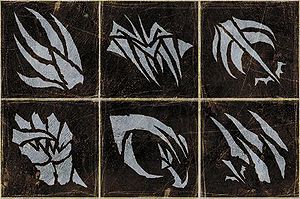
The Charr seem to speak a dialect of "common" with a number of unique words and idioms, and occasionally use grunts and roars.
They do not have a written language of their own, but they do use a limited series of ideograms, as seen on the Charr Battle Plan Decoder wheel. Each ideogram represents a quality or an entity that the Charr admire or respect, such as strength, courage, victory, honor, etc. Charr ideograms were not widely embraced, in part as a reflection of the Shaman caste's draconian rule, until Pyre Fierceshot led the revolt against them. [5]
| Known words, titles, and phrases. | |
|---|---|
| Cub | Juvenile Charr, gender-neutral. |
| Fahrar (also known as a crèche) | Education, school. |
| Hrangmer | Jaws of Oblivion. |
| Imperator | Descendant of the Khan-Ur and leader of one of the High Legions. |
| Khan-Ur | Title of the supreme leader of all Charr. |
| Kit | Juvenile Charr, feminine. |
| Meat | Derogatory term used to refer to humans and possibly other non-Charr. |
| Mouse | Derogatory term used to refer to humans and possibly other non-Charr. |
Grawl[edit]
Other than their own names, the only known Grawl word is a noise rendered as "*oot!*".
Human languages[edit]
Ascalonian[edit]
Ascalonian uses a runic alphabet, making it versatile for writing and clearly translatable. Although most Ascalonians cannot read or write, Ascalonian was easily recognized and was used everywhere on contemporary structures and ancient artifacts, as well as other sources.[7]
Elonian dialect[edit]
There is no Elonian language as much as there is an Elonian dialect with various words and phrases used alongside "common." Elonian words are generally only used in place names, making it difficult to determine their meanings through context.
| Known words and phrases. | |
|---|---|
| Ahai | Greeting. |
| Anur / onur / nur | Suffixes used in the names of various settlements. |
The written language of Elona can be found throughout Istan, Kourna, and Vabbi - the prime location being scrolling runes in the Halls of Chokhin called "stacks" by the librarians. They can also be found on the "plinths" - large pillars with a purple glow - found throughout the Realm of Torment and in Bloodstone Caves.
- Ancient Elonian script
In addition to the modern Elonian written language, examples of Elonian inscriptions from the Primeval Dynasty can be found in Istan. These are notably different from modern Elonian text, and most Elonians cannot read this script.
This ancient script can be found on various things related to Nightfall, such as the corpses of diggers excavating Fahranur, The First City, and on Graven Monoliths.
Old Canthan[edit]
The spoken version of the old language of Cantha has been largely supplanted by "common." Nowadays, there are few people who speak the Old Canthan language, however, a number of words and phrases have been integrated into the Canthan dialect of "common."
While Old Canthan is hardly spoken anymore, the written version is still widely used throughout Cantha and it is near impossible to move around without seeing uses of Old Canthan.
| Observed words, phrases, and sentences | |
|---|---|
| Chang | Lord |
| Jaje Niya | Precious Treasure |
| Kaineng | Emperor |
| Mo Zing | Describes people who have no master, or guild, that they follow (like rōnin in japanese culture) |
| Naitahlen | Pirate(s) |
| Pahbahzhen | A form of greeting |
| Ran musu | Blue moon |
| Tahkayun | Assassin |
| Weh no Su | Closer to the stars/Near the Stars |
| Zhu Hanuku | Old Long Arms |
| Hai Jii | The Phoenix, the representation of fiery eternity in the Underworld |
| Kaijun Don (or Kai Jun Don) | The Kirin, the embodiment of corruption |
| Kuonghsang (or Quon Sang) | The Turtle Dragon, the eternal paradox |
| Tahmu (or Tah Mu) | The Dragon, a reminder of atrocity, pain, and anguish |
| Kei na Kai | Unknown. Seen in Tahnnakai Temple mission, in A Master’s Burden and in Power Surge. Probably an old saying referring to Kaijun Don. |
| Cong a tae? Ah lo rai fat.... Cam bau len ah kao? | Unknown. Seen in Tahnnakai Temple mission (Kaolai may be trying to remember who he is - he'll say later in the story when asked for advice : "I know not who I am, but somehow I know this: you must now [...]") |
| Ah raion ii! ; Dun ah! ; U man ah kao zaa yundin | Unknown. Seen in Tahnnakai Temple mission (Bound Kaolai's cries of regret and agony when fighting him) |
| Ah ja singka ra beh. Ah ka Vizu jai! Behnu ra fan kuu! ; Ah him ra beh yan. | Unknown. Seen in Tahnnakai Temple mission (Kaolai's words after being freed, while the player is going forward to save Vizu) |
| Ah sang beh | Unknown. Seen in Tahnnakai Temple mission (Bound Vizu: "Get away from me, demons! Ah sang beh!") |
| Huu na mang | Unknown. Seen in Tahnnakai Temple mission (Bound Vizu: "I serve Cantha, not that huu na mang! He is a traitor to his Emperor!") |
| Pongmang | Unknown. Seen during Finding The Oracle (Nika: "Get your hands off me, pongmang! You are unfit to touch me!") |
| Kai sang | Unknown. Used as an epithet during Finding The Oracle (Nika: "I said...get...your...kai sang...hands...off...me!") |
| Ku kao Xa'ah, ikah tanra bah nae | Unknown. Seen in Raisu Palace mission (Shiro Tagachi says that when the player reaches him at the end of the mission) |
| Rai, cambah nuang | Unknown. After completing the Raisu Palace mission (Vizu:"Togo is dead? Rai, cambah nuang! What a loss! I pray the envoys guide him quickly and safely home to the Mists.") |
Old Canthan writing system[edit]
Known Canthan logograms[8]
Old Kurzick[edit]
Along with Old Canthan, an old form of the Kurzick language still exists in Cantha. However, the only known example of Old Kurzick is the Songs of Arboreum, performed by the Tree Singers during the Eternal Grove mission, its lyrics are as follows:
- "A sanctu al defender zu arboretum."
- "Par itzkein zein mysterium."
- "A eternum al arboreum."
- "Per edora resurrekti zu mortikum."
The chant appears to be a mixture of English, Latin, Yiddish, and German. A rough fan-made translation is:[9]
- "A holy protector to defend the forest."
- "Equal in the mystery."
- "An eternal tree."
- "By which we resurrect the dead."
Old Krytan[edit]
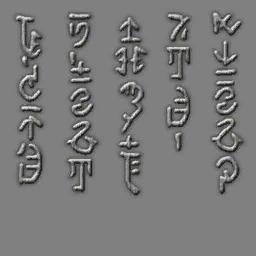
Old Krytan uses a series of runes that is usually arranged in a vertical format and is more akin to primitive syllabary than an alphabet. Due to the heavy use of contextualization, which is only easily understandable to the most learned scholars, Old Krytan began to fall out of favor with modern Krytan citizens. However, Old Krytan still shows up on some Druid stones, ruins, signposts, and a handful of other places.[7]
Old Krytan was extremely hard to use due to the pronunciation of runes changing depending on if the rune was alone or in a particular order to other runes, with changes in order changing the sound of the rune. Effectively, switching the order of two runes give a completely different sound (e.g., One sounds like "AH" and the other sounds like "MUH," when combined to make a simple word, they can either create "ACH-MEH" or, if reversed, "MIH-YEH").[10]
Mursaat[edit]
Not much is known of the runes belonging to the Mursaat, however they are found in two locations: In Shaemoor, where the Eye of Janthir sits, and in the Hall of Judgment.
It is unknown if their placement in the Hall of Judgment is canon to lore, due to the limit of resources the Live Team had when the area was created.
Titan[edit]
The Titan language, along with Titan names, seems to be based on latin. There is currently only one known phrase:
- "Shith Mal Hacto!"
Unknown runes and languages[edit]
Little is known about most runes found throughout world, leaving them as complete mysteries to most.
Gallery[edit]
Runes found on various stones in the Maguuma Jungle.
Runes found on various signposts in the Crystal Desert.
Runes found within Augury Rock.
Runes found on the teleportation circles.
Hieroglyphs found on some Kournan ships.
Runes found on various Vabbian signposts.
Runes found on various signposts in the Far Shiverpeaks.
Ephemeral Spirit[edit]
| Cipher | English | Cipher | English | Cipher | English | Cipher | English | |||
| A | S | B | U | C | V | D | T | |||
| E | R | F | — | G | — | H | Y | |||
| I | W | J | O | K | — | L | P | |||
| M | N | N | G | O | I | P | H | |||
| Q | F | R | B | S | D | T | E | |||
| U | C | V | A | W | K | X | M | |||
| Y | L | Z | J | Unused English Letters: X Q Z | ||||||
This language is spoken by the Ephemeral Spirit, the only known speaker of this language, at the end of The Path to Revelations quest. The language follows a substitution cipher.
The original language:
- "Vm'Jqqteomn dj'dpjat ipj'attw"
- "Rthjms'dpt xoada'rthjms dpt'setvxa"
- "Jm'soadvmd apjeta'jq v'yvms bmivwomn"
- "Vmaitea'dptet yot'om ivodomn"
The translation:[12]
- "An offering to those who seek"
- "Beyond the mists beyond the dreams"
- "On distant shores of a land unwaking"
- "Answers there lie in waiting"
The most common runes[edit]
There are runes that appear throughout Tyria, Elona, and the Mists which have an unknown origin. These runes can be found on the walls of the Tomb of the Primeval Kings (though it is near impossible to see them anymore except during Halloween), various doorways, ramps, and pillars throughout the Underworld, various doorways and ramps in the Catacombs, on banners hanging from various tents in Ascalon and Kryta, in a few locations in Vabbi, primarily Forum Highlands, and throughout the path to the Hall of Heroes (such as Burial Mounds).
Despite these being the most widespread set of runes, there is nothing ever stated on them. They are sometimes accompanied by an eye-like symbol which is seen on pedestals which contain Mursaat runes on them, any connection is unknown. The runes are also often accompanied by a circle or a series of circles which contain the runes in layers.
Trivia[edit]
| The Guild Wars 2 Wiki has an article on Languages of Tyria. |
- Matthew Medina took inspiration from the Phoenician alphabet when creating the Ascalonian runes, which were one of the first alphabets developed for Guild Wars.[13]
- Bookah may be a reference to the Japanese word "buka" meaning subordinate, the Japanese word "baka" meaning "idiot," the Russian word "Бука" meaning sulky man, or the Polish cartoon character Buka, which is a giant monster that grunts and scares families.
- The asuran banners contain a reference to Riley Martin.
- In the War in Kryta marketing campaign, ArenaNet used the Ascalonian runes as codes for players to find the next website page.
References[edit]
- ^ Comment by Matthew Medina, Guild Wars Wiki
- ^ Comment by Matthew Medina, Guild Wars Wiki
- ^ I've cracked the Asuran alphabet, Reddit
- ^ Dougal Keane, Ghosts of Ascalon novel, chapter 3
- ^ Comment by Matthew Medina, Guild Wars Wiki
- ^ Comment by Matthew Medina, Guild Wars Wiki
- ^ ab Cultural Diffusion in Contemporary Kryta, ArenaNet Blog
- ^ The Official Beginner's Guide to Canthan Language (archived thread), guildwars.incgamers.com
- ^ Fan translation of the Songs of Arboreum, Guild Wars Guru
- ^ Comment by Matthew Medina, Guild Wars Wiki
- ^ Comment on various runes, Matthew Medina
- ^ Translation of the Ephemeral Spirit's dialogue, guildwars.incgamers.com
- ^ More Historical Artifacts from Tyria, Matthew Medina's blog
| Lore (edit) | |
|---|---|
| Cultures & History | Ecology • Government • Language • Magic • Race • Religion • Species • Timeline |
| Architecture | Architecture of Elona |
| Genealogy | Elonian Royalty • Imperial Dynasty • Tyrian Royalty |
| Storylines | Prophecies • Factions • Nightfall • Eye of the North • Beyond |
| Stories | Chapters: (1) The Wall • (2) The North • (3) The Nolani Academy of the Arcane Arts • (4) The Shiverpeaks • (5) The Dwarves • (6) The Wilds • (7) The Rift • (8) Chasing a Legend The Battle for Kyhlo • The Protectors of Kryta • Sorrow's Furnace |
| Letters | History of Tyria • An Empire Divided • Letters from Kuro • Letters from Neiro • Letters from Togo • War Chronicles • Miku's Tale |
| Lore documents | Canthan Culture • Conflict in Cantha • History of Elona • Nightfall • GW:EN and Now History of the Shining Blade • The Story of the White Mantle • For the Future of Cantha! |
| Cinematics | Core • Prophecies • Factions • Nightfall • Eye of the North • Bonus Mission Pack |
